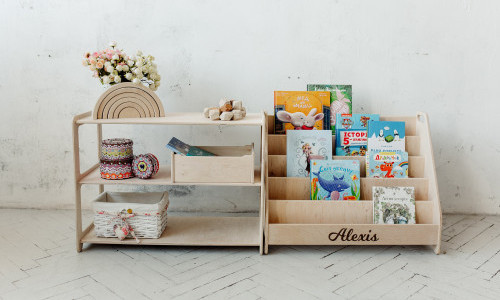Montessori shelf is an essential component of Montessori-inspired spaces, whether at home or in educational settings.
Don’t worry, you can have one even without a Montessori setup.
You are in the wrong place only if you are not looking for details about:
- the Montessori shelf concept
- popular Montessori shelf ideas
- tips & tricks to choose one
Whether you are in for a Montessori shelf with hidden storage or a simple bookshelf, you are due to find it, guaranteed, throughout our material.
Let’s dig in!
What Is A Montessori Shelf?
A Montessori shelf is a type of shelving unit designed to be accessible, organized, and practical, allowing children to engage in independent play and exploration.
Rooted in Montessori principles, the Montessori shelves aim to foster a child’s natural curiosity and promote self-motivated learning experiences.
The idea behind them is to create an environment where kids can easily access and select materials that interest them.
When setting up a Montessori environment at home, one of the most important aspects to consider is the organization and display of materials.
This is where Montessori shelves come into play.
Montessori shelves are designed to be low, open, and easily accessible so that children can independently reach their toys, materials, and activities without adult assistance.
We believe that having dedicated Montessori shelves at home is crucial for fostering self-directed learning and independence.
A well-organized Montessori shelf will typically hold a variety of materials, such as books, toys, and learning activities.
Clear organization and presentation of materials encourage children to engage with them, learn at their own pace, and return them to their proper place once they are done.
In turn, this setup helps to promote responsibility, concentration, and independence among young learners.
An excellent example of a Montessori-inspired shelf is the Lovevery Montessori shelf.
Here are some key characteristics of Montessori shelves that facilitate the learning experience:
- Made from natural materials, such as solid wood, to promote a warm, aesthetically pleasing atmosphere.
- Open and low, allowing children to easily see and reach materials on their own.
- Organized with a specific purpose and intention, clearly displaying materials orderly.
- Featuring a limited number of items, allowing children to focus on each material and avoid clutter.
By incorporating Montessori bookshelves, toy shelves, and space for learning activities, we can support our children’s independence and promote a love for exploration and learning.
The Benefits Of Montessori Shelves
We believe that Montessori shelves have numerous advantages for both children and parents.
The primary benefit is promoting a child’s independence and self-reliance.
The open, uncluttered setup of Montessori shelves encourages children to confidently choose and engage in independent play.
This freedom empowers them to explore their interests and make decisions on their own.
Another key advantage is that Montessori shelves aid in creating an organized learning environment.
The shelves are designed to display toys and materials neatly, making it easier for children to find and return items.
By using baskets or trays, we can help children keep their space clean and tidy, reducing clutter and stress for both children and parents.
In addition, Montessori shelves facilitate a more dynamic learning experience.
We can periodically rotate and update the items on the shelves to maintain children’s interest and curiosity.
This also exposes them to new materials and activities, broadening their horizons and providing continuous opportunities for growth and development.
Implementing Montessori shelves at home can inspire child-driven play and teach ownership and accountability for their belongings.
As Amanda Vierheller from TheBump.com states, these shelves are set up in such a way that allows children to manage their playthings, instilling a sense of responsibility in them.
Ultimately, incorporating Montessori shelves into a child’s environment supports their growth toward becoming capable, independent learners.
Through these shelves, we can create a space for children to thrive and develop valuable life skills while maintaining a harmonious and organized atmosphere for the entire family.
Selecting The Right Size
Regarding Montessori shelves, selecting the right size is essential for young learners.
Size matters in terms of both height and depth.
Let’s discuss these factors to ensure that we make the best choice for our child’s learning environment.
Below you can find a representative size chart from 0 to 6 years.
| Age Range | Height | Depth |
|---|---|---|
| Up to 12 months | ~12”/30cm | ~10”/25cm |
| 1 – 2 years | ~24”/61cm | ~12”/31cm |
| 2 – 3 years | ~ 34”/86cm | ~13”/33cm |
| 3 – 6 years | ~ 42”/106cm | ~14”/36cm |
Selecting the appropriate height is essential.
As you can see, the ideal height for a Montessori shelf varies based on the child’s age.
It is important to choose a shelf that is easily reachable and accessible to promote independence and prevent accidents.
If your child is off-standard (behind or ahead) in height, keep that in mind when getting a shelf.
In our case, Anastasia is one size behind therefore we always get height-related products accordingly.
The depth is also relevant, yet not so critical since most of the products are within close range.
In general, a depth of 11”-12” will fit any age.
This depth ensures that items are visible and reachable for the child, while still preventing clutter and disorganization.
In conclusion, when selecting Montessori shelves, we must prioritize adequate height, depth, and safety to ensure a proper environment for your loved one.
Montessori Shelf Materials
When it comes to selecting Montessori shelves, we must pay attention to the materials used in their construction.
A high-quality Montessori shelf should be sturdy and safe for young children to use, with no risk of tipping over.
We recommend looking for shelves made of hardwood like pine or birch, as it is an eco-friendly and durable wood choice for Montessori materials.
Plywood is still a good option (usually cheaper) if you don’t have anything against it.
The wooden shelves should be designed with children in mind, featuring smooth edges and simple, uncluttered lines.
This allows for easy access and display of various learning materials, making it effortless for the child to observe and select the items they wish to engage with.
We also favor uncoated, unpainted, and unglued Montessori shelves but the presence of these enhancements doesn’t usually pose a risk.
The Main Categorie Of Montessori Shelves
There are various shelves suitable for different aspects of a Montessori environment.
The most popular Montessori shelves are:
Montessori Toy Shelf
Montessori Book Shelf
Montessori Combo Shelf
The Montessori Toy Shelf
The Montessori toy shelf is designed to store and display children’s toys and play materials.
Toys are generally organized in bins or baskets on the shelves, making it easy for children to find and put away their playthings.
The Montessori toy storage ideas can help you choose the right toy shelf for your needs.
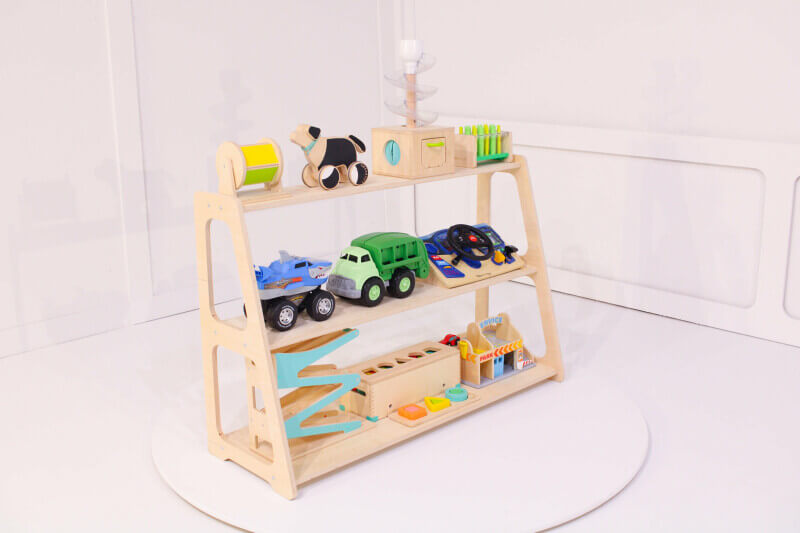
The Montessori Book Shelf
Montessori bookshelves specifically cater to displaying books in an organized manner.
These shelves usually have a front-facing design, allowing children to see the covers of the books, and enticing them to read.
Providing a clear display of the book covers encourages children to choose books independently, fostering a love for reading at an early age.
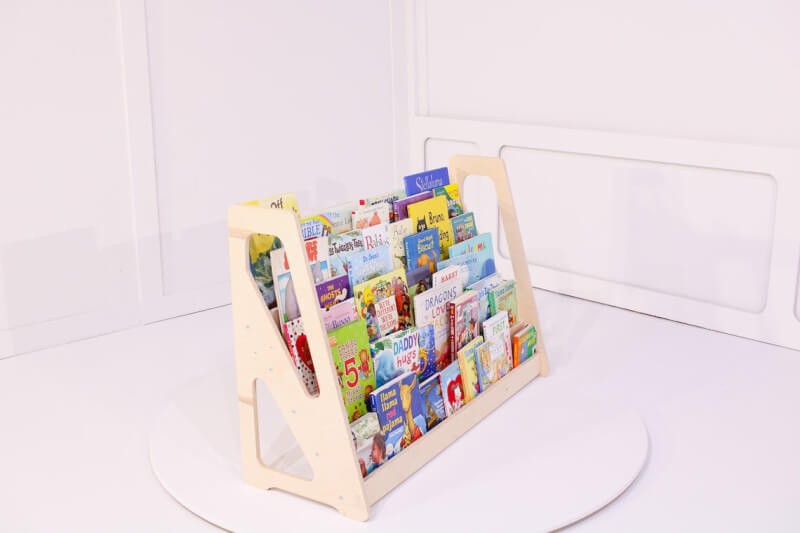
The Montessori Combo Shelf
These shelves include storage for both toys and books in one unit.
These shelves are designed to be versatile and functional, offering a space-saving solution for Montessori environments with limited room.
Combination shelves can come in various shapes and sizes, making it simple to find the perfect fit for your space.
They tend to have a big drawback since they are part of the same unit: There isn’t enough space for either, books or toys.
We wouldn’t recommend it unless you have a tiny space available.
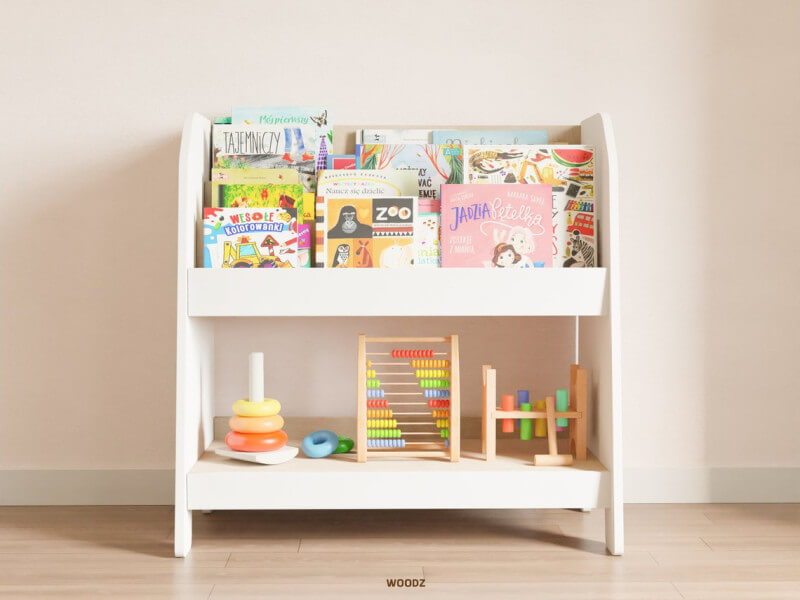
(Not So) Montessori Floating Shelves
It’s important to mention that floating shelves are not quite Montessori.
Their standard setup is usually at an adult height level and the purpose is to keep things out of reach of children.
If you insist, you can build a structure at a child’s level but we believe the effort and risks of your kids mounting them are not worth it.
In summary, Montessori shelves are available in various types to suit the unique needs of children and their caregivers.
Montessori Shelf Organization
Planning & Assembling
When setting up Montessori shelves, it’s essential to use the instructions from the manufacturer and don’t improvise.
Depending on the age of your child, you may or may not want to involve them in the process.
We recommend investing in quality Montessori furniture made from natural materials like wood, which you can find on platforms like Etsy, Amazon, Lovevery, and other renowned platforms.
During the assembly process, it’s crucial to ensure that parts come together properly.
Place trays or small containers that are easy for the child to lift and carry on the shelves.
This will allow them to choose their desired activity independently.
Organization
An effective Montessori shelf setup includes a well-organized system for toy storage and rotation.
Here are a couple of essential steps to organize a Montessori shelf:
1. Limit the number of activities/articles
The number should be proportional to the available space.
If your Montessori toy shelf is similar to a Kallax from IKEA, 1 activity/article (at max, 2) should be available per unit.
2. Book reading setup
Toys and activities’ difficulty should be increasing from left to right and top to bottom.
This structure will start to build the logical progression concept in your kid’s brain, helping later with other activities, such as reading.
3. Visible and within reach articles
Articles shouldn’t be hidden completely behind or inside other items or spaces.
Also, your child should be able to reach them with minimum effort.
4. Tray/Basket display
Articles/activities with several components (e.g. shape sorters, blocks) should be placed on trays or in low-height baskets so the child can carry them around.
5. Let activities undone
Having toys or activities undone will engage your child to go for it.
This was one of our biggest mistakes at the beginning with Anastasia and we were wondering why the lack of interest.
Toy Rotation
Incorporate a toy rotation system to maintain the child’s interest and foster development in various learning areas.
Regularly rotate the toys and materials on the shelf to avoid boredom or overcrowding.
Aim to create a balance between familiar toys that reinforce gained skills and new activities that challenge the child.
This can be done on a weekly or biweekly basis, depending on the child’s needs and interests.
Here are some steps for organizing and rotating toys:
1. Categorize toys and materials
Sort them according to their nature (i.e., sensorial, practical life, art, puzzles, etc.).
2. Evaluate the child’s interests and abilities
Choose activities that align with their current developmental level and interests.
3. Rotate toys
Replace a few toys every week or two, depending on the child’s engagement and progress.
The best approach would be to engage your child in the toy refresh process.
Ask them what they would like to “put to sleep” and who should “come to play”.
This will increase their independence and decision-making skills and reduce the stress of change in their world.
Design & Placement
The design and placement of your Montessori shelves play a significant role in creating an engaging and accessible learning environment.
Ideally, the shelves should be positioned in an uncluttered area of the home, such as a bedroom, living room, or playroom with ample space for children to move and explore freely.
Natural light and ventilation are also important factors, as they help create a comfortable setting to encourage focus and learning.
Arrange the activities in a visually appealing manner, using clear labels or symbols for easy identification.
Providing an attractive and organized setup allows children to develop responsibility, independence, and a sense of ownership over their learning environment.
In conclusion, setting up a Montessori shelf requires careful planning, organization, and attention to design elements.
Ultimately, creating a child-centered learning space that fosters autonomy and curiosity is key to the Montessori approach.
Montessori Shelf Care And Maintenance
Keeping your Montessori shelf clean and organized is essential for creating a stimulating learning environment for your child.
First, it is necessary to establish a regular cleaning routine to ensure the shelf and its contents remain in optimal condition.
We suggest dusting the shelves and toys at least once a week to minimize the accumulation of dust and dirt.
Use a damp cloth or a gentle cleaning solution to wipe down the surfaces, and pay close attention to the corners and spaces between the toys.
For uncoated shelves (personal experience) we recommend keeping any coloring tools away from it.
In addition to weekly dusting, we recommend a thorough cleaning of the entire shelf every few months.
Remove all the materials from the shelves, and inspect each item for damage or wear and tear.
Discard/fix any broken toys, and replace them with new ones as needed.
If necessary, sand any damaged areas to avoid accidents due to splinters or cracks.
This process not only ensures the safety of your child but also allows you to reevaluate the toys and materials you provide.
Cleaning up after playtime is a crucial aspect of maintaining order in a Montessori environment.
Encourage your child to put their toys and materials back in their designated spots.
By involving your child in the clean-up process, you are teaching them responsibility and independence.
Start by modeling the clean-up process, and gradually allow your child to take a more active role as they become familiar with the system.
In summary, a well-maintained Montessori shelf is paramount for fostering a stimulating and organized learning environment.
By establishing a cleaning routine, involving your child in the clean-up process, and rotating materials regularly, you can ensure the longevity and effectiveness of your Montessori shelf.
Creating a Montessori Home
We believe that incorporating Montessori-inspired elements into your home is an excellent way to nurture independence and promote a love for learning in your child.
If you are in for the long run, here are a few high-level steps toward creating a Montessori place for your child.
Adding Montessori Furniture
To create a Montessori environment you will need more than a shelf or two.
It’s essential to include child-friendly furniture that promotes self-sufficiency.
The most popular Montessori pieces to get you set up are:
1. The Montessori Playshelf
If you reached this point you already know what we are talking about.
2. The Montessori Wardrobe
A low open wardrobe with accessible drawers and hanging rods encourages children to dress themselves and develop a sense of ownership over their belongings.
3. Tables & Chairs
Child-sized tables and chairs enable little ones to engage in activities comfortably at their level.
This also supports the development of fine motor skills and concentration.
4. Pikler Triangle
The Pikler triangle, often associated with Waldorf education, is an excellent addition to a Montessori home, allowing for physical development and exploration within a safe environment.
We’ll be going in-depth about a Montessori home and other Montessori pieces in our future articles.
Feel free to explore our Montessori toys articles that complement such an environment.
Fitting The Montessori Philosophy
In addition to furniture, incorporating Montessori principles into your home involves creating a space that encourages exploration, curiosity, and free play.
Here are some ways to do that:
1. Organization
Keep toys, materials, and other belongings organized to make them easily accessible to your child.
This can include clearly labeled bins, shelves, and pegs for hanging items like coats or bags.
2. Paring down
Limit the number of toys and materials available at any given time.
This will help maintain a clean, clutter-free environment while also encouraging children to engage more deeply in their chosen activities.
3. Rotating materials
Regularly swap out toys and materials to maintain your child’s interest and to introduce new challenges and learning opportunities.
4. Independence
Encourage independence by providing opportunities for children to make choices and complete tasks on their own.
This can include simple chores like setting the table, watering plants, or helping with laundry.
In conclusion, creating a Montessori home involves careful consideration of the furniture arrangement, interior design, and daily routines.
By incorporating these ideas into your environment, you can foster the growth and development of your child according to Montessori principles.
Where To Buy Montessori Shelves
Everywhere.
Today it’s easy to get your hands on Montessori products since we have huge online retailers facilitating safe and fast shipping to any corner of the world.
If you’re looking to create a Montessori-inspired environment at home, having a Montessori shelf is essential.
To help you find the perfect option, we have compiled a list of places where you can buy high-quality Montessori shelves and more.
Etsy
When you say (quality) wood, you say Etsy.
This platform is known for offering unique and handmade items, allowing you to find a wide range of styles and designs.
In addition to Montessori shelves, you can also discover Montessori toys and clothing racks, perfect for your little one’s learning space.
Plus, many Etsy sellers offer shipping options for added convenience.
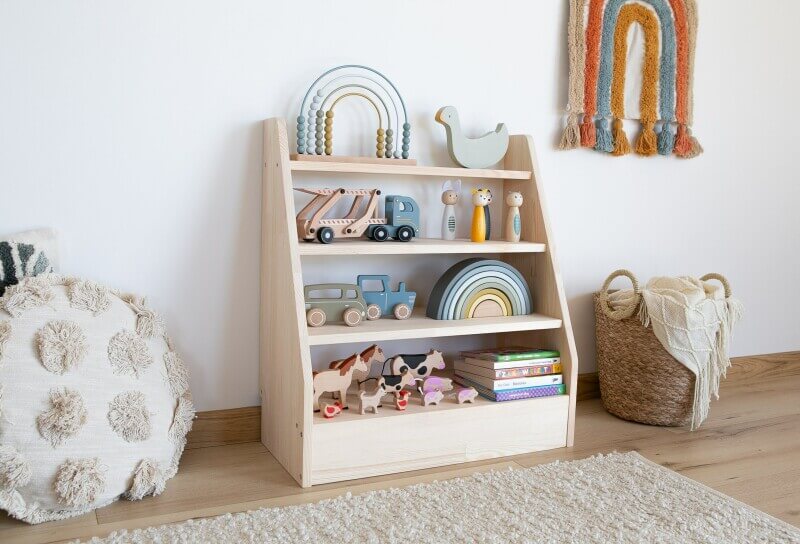
Lovevery
Lovevery is a highly respected name when it comes to educational toy subscription services.
Their curated collections of toys and learning materials are perfect additions to your Montessori environment.
But they also feature a well-crafted Montessori Playshelf fitting any nursery.
It’s also a Montessori shelf with hidden storage, a feature becoming more and more present with other brands.

Consider Lovevery products alongside your newly purchased Montessori shelf to create a well-rounded learning space.
Find out more about their exquisite products in our dedicated articles:
Amazon
Here, you can quickly compare a wide range of Montessori shelves and storage options.
Compared to Etsy, the range is not endless, but you can find affordable and cool designs to pick from.
Montessori Outlet
MO is another great place offering a variety of options that are crafted based on the AMI standards and authentic blueprints.
With competitive pricing and quality materials, they are worth considering if you’re looking for reliable storage solutions.
IKEA
For those of you who prefer shopping in person, IKEA can be a good choice.
Although they do not specifically sell Montessori shelves, their wide range of modular shelving units can be adapted to create an ideal Montessori setup.
Just look for models with low, open shelves to enable easy access for children.
A straight-up suggestion for those looking for a white Montessori shelf would be the well-known Kallax many parents use.
Other Well-Established Online And In-Store Retailers
As you can imagine, you have endless options to identify the perfect Montessori shelf.
If the options above are not enough, here are some honorable mentions when it comes to Montessori shelving:
- Walmart
- Target
- Sprout
- Guidecraft
- Rad
- Wayfair
- Wildkin
- Community Playthings
- Little Colorado
- Pottery Barn Kids
We hope this list can help you find the perfect Montessori shelf for your little one’s learning environment.
Remember to focus on materials, dimensions, and design, and consider how each option would fit within your existing space and decor.
Frequently Asked Questions
Do I need a Montessori shelf?
While not strictly necessary, having a Montessori shelf can greatly enhance the Montessori experience for your child.
It promotes organization, independence, and a child-centered learning environment.
If you’re committed to the Montessori approach, we highly recommend investing in a high-quality Montessori shelf.
Why is the Montessori shelf important?
A Montessori shelf is important because it fosters independence and a sense of order in your child’s learning environment.
The open, low design allows children easy access to their toys and materials, encouraging them to explore and engage in independent play.
What age is the Montessori shelf for?
Montessori shelves can be used for children of all ages, from infants to early elementary school-aged children.
The key is to adjust the height of the shelves and the items displayed based on your child’s age and abilities.
Why are Montessori shelves so expensive?
Montessori shelves tend to be more expensive because they are (hand)made with high-quality natural materials and are designed to meet specific Montessori principles.
However, there are budget options available or you can even create your own Montessori shelf with a bit of creativity and some basic woodworking skills.
Why are Montessori shelves open?
Montessori shelves are open to provide easy access to toys and materials without overwhelming children with too many options.
The open design encourages independent play and helps children maintain an organized environment.
How many items should be on a Montessori shelf?
There is no specific number of items that should be on a Montessori shelf, as this depends on your child’s age, interests, and developmental needs.
The rule of thumb is to display a few carefully chosen toys and materials that are well-suited to your child’s current skills and interests.
What are the typical Montessori shelf dimensions?
Montessori shelf dimensions can vary depending on the age and needs of your child.
The height should be easily accessible and allow the child to take and replace items independently.
The width and depth should be adequate to accommodate various-sized toys and materials.
How do you arrange Montessori shelves?
Arranging Montessori shelves involves placing items in an orderly and accessible manner.
You can group similar items, or organize them by difficulty or developmental stages.
Encourage your child to maintain this organization by returning items to their designated spot after use.
What are some Montessori shelf ideas for different age groups?
For younger children, you may want to include simple, engaging toys like softballs, stacking rings, and nontechnical puzzles.
As your child gets older, you can introduce more complex toys like alphabet blocks, number games, and art supplies.
Remember that the specific items on your Montessori shelf should cater to your child’s needs and interests.
How can you create a Montessori toy storage system?
A Montessori toy storage system involves using Montessori shelves to display and organize toys, materials, and activities.
Each item should have its designated spot on the shelf, often placed in a tray or basket for easy removal and replacement.
Maintain the system by continually evaluating the relevance and challenge of the toys displayed and rotating them as needed.
Key Takeaways
If we are to summarize the most important things we’ve learned today, these will be:
- Montessori shelves promote independent play and exploration based on Montessori principles.
- A well-organized and accessible shelf supports self-motivated learning experiences for children.
- Selecting the right size and material is important when choosing a Montessori shelf to suit your space.
I trust you enjoyed the information we gathered for you and you will put it to good use.
If you have any questions, tips, curiosities, or experiences to share, please use the comments section below.

